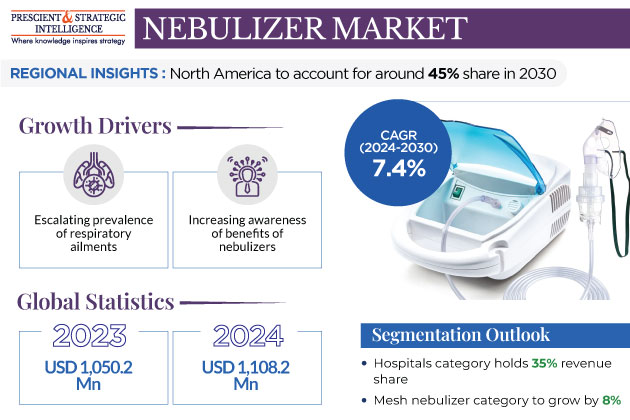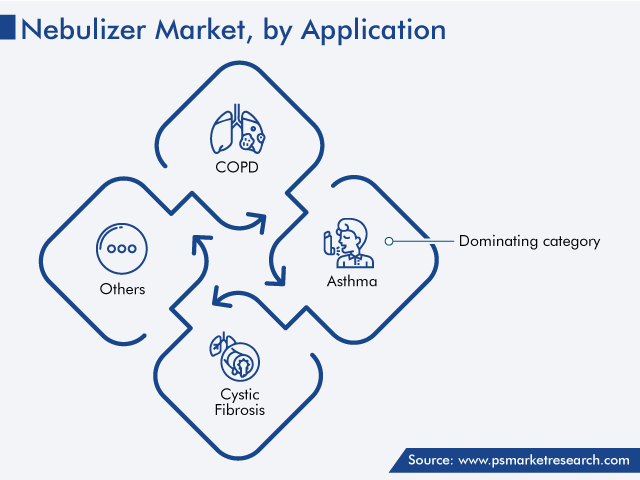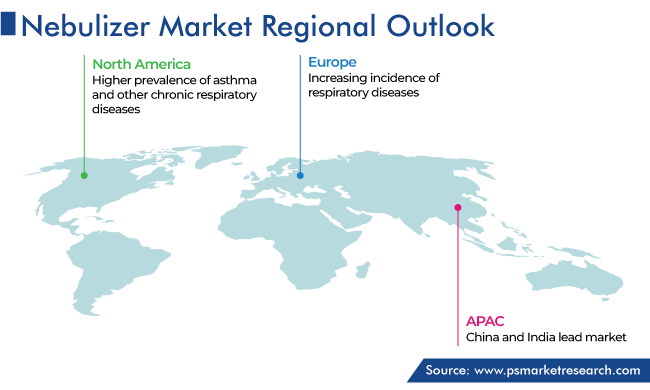Report Code: 12080 | Available Format: PDF | Pages: 260
Nebulizer Market Size and Share Analysis by Type (Jet, Mesh, Ultrasonic), Application (COPD, Cystic Fibrosis, Asthma), End User (Hospitals, Clinics, Emergency Centers, Home Healthcare Centers), Portability (Tabletop, Portable) - Global Industry Demand Forecast to 2030
- Report Code: 12080
- Available Format: PDF
- Pages: 260
- Report Description
- Table of Contents
- Market Segmentation
- Request Free Sample
Nebulizer Market Overview
The nebulizer market size stood at USD 1,050.2 million in 2023, and it is expected to reach USD 1,696.7 million by 2030, with a compound annual growth rate of 7.4% during 2024–2030. This can be ascribed to the rising geriatric population, soaring consumption of cigarettes, surging cases of respiratory and chronic diseases, and increasing demand for home healthcare devices.

- For example, chronic obstructive pulmonary disease is the fourth leading cause of death in the U.S., according to the Centers for Disease Control and Prevention.
- Additionally, increased consumption of highly processed products such as alcohol, tobacco, and sugar-sweetened beverages is a major contributor to the increased prevalence of respiratory diseases in North America.
- According to the CDC, approximately 14% of deaths among adults between the ages of 30 and 70 in North America are caused by tobacco use.
- Additionally, it is never easy for new technologies or devices to take off in developed markets, especially given the complexity of several national regulatory and reimbursement systems that must be adhered to for both medications and devices.
- There is a higher number of components, important parts, and assemblies connected to both mesh and electronic control circuits.
- In addition to this, mesh nebulizers, which have been in clinical trials since 2006 by well-known businesses including Philips, Ventura, and Pari Gabh, are projected to have rapid expansion in the coming years.
Escalating Prevalence of Respiratory Ailments Drives the Market
The nebulizer market is propelled by the escalating prevalence of respiratory ailments, attributed to heightened pollution levels and evolving lifestyles. Elderly people are more vulnerable to respiratory disorders and chronic conditions and are more likely to suffer from chronic respiratory conditions. This surging respiratory issue is set to increase the demand for nebulizers.
Furthermore, due to the increasing awareness of the benefits associated with nebulizers, these devices have become widely used in the treatment of respiratory conditions such as asthma and COPD. Additionally, they are utilized for efficient delivery of medication directly to the lungs. In addition, their user-friendly design, portability, and ability to provide rapid relief contribute to their growing popularity over alternative inhalation methods.
In the market, the availability of advanced, portable nebulizers is also driving the market, as they are smaller in size and can be easily carried around and are also more effective and offer quick relief.
Additionally, healthcare players are increasingly focused on home-based and self-care treatments, which increases the demand for nebulizers. Patients are now seeking convenient and effective ways to manage their respiratory conditions from the comfort of their homes, and nebulizers provide the reliable.
Mesh Nebulizer Category To Witness Lucrative Market Growth
- The mesh nebulizer category is expected to witness lucrative growth over the projected period, as it is a technologically advanced compact-sized device that minimizes drug loss, increases patients’ acceptance, helps in quick treatment, and is portable and convenient.
- Moreover, the increasing commercial acceptance of mesh nebulizers is also contributing to market penetration, due to precise drug delivery to the lungs and reduced residual amounts.
- For example, HCmed received USFDA approval in July 2022 for Pulmogine, a portable vibrating mesh nebulizer designed to deliver medication directly to the respiratory tract.
- As per a journal, several independent product reviewers in the healthcare business named ProNebu as the best portable nebulizer in 2022. The brand has revolutionized with its pocked size, extremely silent, handheld design, and cutting-edge vibrating mesh technology, and it only needs two AA batteries or a USB wire to operate.
- Unlike traditional jet nebulizers that use noisy air compressors, ProNebu mesh nebulizer requires no compressor, air source, or hose. This saves the time required to set up a device.
| Report Attribute | Details |
Market Size in 2023 |
USD 1,050.2 Million |
Market Size in 2024 |
USD 1,108.2 Million |
Revenue Forecast in 2030 |
USD 1,696.7 Million |
Growth Rate |
7.4% CAGR |
Historical Years |
2017-2023 |
Forecast Years |
2024-2030 |
Report Scope |
Market Trends, Drivers, and Restraints; Revenue Estimation and Forecast; Segmentation Analysis; Impact of COVID-19; Companies’ Strategic Developments; Market Share Analysis of Key Players; Company Profiling |
Segments Covered |
By Type, By Portability, By Application, By End User, By Region |
Explore more about this report - Request free sample
Portable Nebulizer Remains in the Highest Demand
- The portable nebulizer category generates the highest revenue, due to the burgeoning geriatric population and its mounting demand for convenient treatment.
- For instance, currently, the world’s aging population is around 962 million over 60 years of age, which will increase to 1.5 billion by 2050.
- The unique features of these devices, such as small size for easy home use, are likely to increase the demand for these devices.
- Moreover, a nebulizer device converts medication into a mist and delivers it directly to the lungs.
- The nebulizer method is commonly used to treat respiratory conditions including asthma, cystic fibrosis, and COPD.
- In addition, the rising number of players in the manufacturing of wearable devices is expected to boost the growth of the wearable segment significantly during the forecast period.
Nebulizer Usage Is Widest Among Asthma Patients
The asthma category, in the application segment, holds the largest share in the market, due to the surging number of asthma cases. For instance, according to the NCIB, asthma is the 16th most common cause of illness based on disability-adjusted life years. Approximately 300 million people worldwide suffer from asthma, and an additional 100 million people could be affected by the disease by 2025. Asthma is the most common chronic disease in children.

Hospital Category Dominates the Market
Hospitals generate the highest demand for nebulizers in the market. This is mainly due to the increased demand for nebulizer devices in hospital settings, particularly driven by a higher number of patient admissions among individuals with comorbidities. For instance, in June 2022, the proportion of children’s emergency hospital admissions for bronchiolitis in the U.K. rose to 68.3% in 2021 from the level of 60.8% in 2014 as per the data of GOV.UK.
Whereas, the home care category is expected to witness the fastest growth in the coming years. This can be because patients tend to prefer aerosol treatment at home rather than going to clinics or hospitals. Moreover, the growing need for home care and the advent of new, lower-cost portable nebulizers have played an important role in the surging demand for these devices in home care settings.
North America Generates the Highest Revenue
On the basis of region, the North American market size reached around $500 million in 2023 and it is also expected to continue to dominate the global market during the forecast period.
- The higher prevalence of asthma and other chronic respiratory diseases, and the increasing use of advanced wearable devices in the region have contributed to the surging demand for such devices in North America.
- For instance, according to statistics released by the Asthma and Allergy Foundation in 2022, about 25 million people in the U.S. were living with asthma.
- In addition, full return policies for these devices in the region are likely to boost the regional market growth.
Europe is the second-leading region in terms of sales and market share of nebulizers because of the increasing incidence of respiratory diseases, which contributes to the increased demand for these devices.
- For example, according to statistics published by GOV.UK in 2022, 1.1 million hospitalizations for respiratory disorders have been recorded in the U.K. As a result, the increasing incidence of respiratory diseases in the region is contributing to the growth of the market.
Whereas, the Asia-Pacific market is expected to witness the fastest growth in the coming years. This can be driven by the increasing prevalence of chronic respiratory diseases, the improvement of healthcare infrastructure, and the rising number of medical device companies developing delivery devices in the region.
On the other hand, the Latin American and the Middle East and African markets are expected to grow significantly during the forecast period. The rapid increase in the prevalence of asthma and COPD will likely accelerate the demand for these devices to control chronic respiratory diseases in their respective region in the coming years.

Companies in the nebulizer industry are collaborating with each other to develop advanced products. For example, in March 2021, Ventec Life System Inc. and General Motors Company collaborated with a U.S.-based private sector organization, StopTheSpread.org, to amplify the production of respiratory care products to combat the coronavirus spread.
Key Players in the Nebulizer Market Are:
- Beurer GmbH
- GF Health Products Inc.
- PARI GmbH
- Allied Healthcare Products Inc.
- Aerogen Ltd.
- Briggs Healthcare
- OMRON Corporation
- Rossmax Swiss GmbH
- Vectura Group Limited
- Becton, Dickinson and Company
- General Electric Company
- Agilent Technologies Inc.
- Medline Industries Inc.
- Koninklijke Philips N.V.
Market Breakdown
This report offers deep insights into the nebulizer market, with size estimation for 2017 to 2030, the major drivers, restraints, trends and opportunities, and competitor analysis.
Segment Analysis, By Type
- Jet
- Mesh
- Active
- Passive
- Ultrasonic
Segment Analysis, By Application
- COPD
- Cystic Fibrosis
- Asthma
Segment Analysis, By End User
- Hospitals
- Clinics
- Emergency Centers
- Home Healthcare Centers
Segment Analysis, By Portability
- Tabletop
- Portable
Segment Analysis, By Geography
- North America
- U.S.
- Canada
- Europe
- Germany
- France
- U.K.
- Italy
- Spain
- Asia-Pacific
- China
- Japan
- India
- South Korea
- Australia
- Latin America
- Brazil
- Mexico
- Middle East & Africa
- Saudi Arabia
- South Africa
- U.A.E.
The industry for nebulizer will reach USD 1,108.2 million in 2024.
The nebulizer market value will reach USD 1,696.7 million in 2030.
The APAC market for nebulizer is growing at the fastest rate.
Increasing incidence of respiratory disorders and the growing consciousness about the advantages of this machine are the key nebulizer industry drivers.
Portable hold the larger nebulizer market share.
Asthma is the leading application in the nebulizer industry.
Want a report tailored exactly to your business strategy?
Request CustomizationWant an insight-rich discussion with the report author?
Speak to AnalystOur dedication to providing the most-accurate market information has earned us verification by Dun & Bradstreet (D&B). We strive for quality checking of the highest level to enable data-driven decision making for you
Our insights into the minutest levels of the markets, including the latest trends and competitive landscape, give you all the answers you need to take your business to new heights
With 24/7 research support, we ensure that the wheels of your business never stop turning. Don’t let time stand in your way. Get all your queries answered with a simple phone call or email, as and when required
We take a cautious approach to protecting your personal and confidential information. Trust is the strongest bond that connects us and our clients, and trust we build by complying with all international and domestic data protection and privacy laws